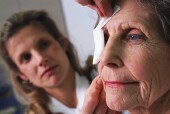
MONDAY, Feb. 18 (HealthDay News) — Drugs and surgery can lower the hallmark inner-eye pressure characteristic of glaucoma — the second-leading cause of blindness in the United States. But research still hasn’t identified the best ways to prevent significant vision loss and improve patient satisfaction, according to a prominent government medical group.
The U.S. Preventive Services Task Force (USPSTF) reviewed dozens of studies and collective reviews on open-angle glaucoma, which accounts for about 90 percent of all cases, concluding there’s inadequate evidence to directly compare the effectiveness of medical, surgical or laser treatments.
The task force, comprised of 16 independent experts in prevention and evidence-based medicine, also said it couldn’t determine whether glaucoma screening for adults without previous vision problems prevents blindness or enhances long-term health.
“We know that treatments are effective, but we don’t know enough to say treatment A is definitely better than treatment B,” said task force co-vice chair Dr. Albert Siu, director of geriatric research, education and the clinical center at James J. Peters VA Medical Center in the Bronx, N.Y. “What we do know is that these treatments are effective in reducing the development and progression in small losses of [peripheral vision]. What isn’t clear is how this translates into reducing vision problems or vision quality of life.”
The task force report is published Feb. 19 in Annals of Internal Medicine.
Open-angle glaucoma affects about 2.5 million Americans, primarily seniors, older blacks and those with a family history, the task force said. Often symptomless, the condition is diagnosed with a combination of tests that show degenerative changes in the optic nerve head and a loss of peripheral vision.
Complicating diagnosis, however, is the fact that many people with open-angle glaucoma don’t suffer from characteristically increased pressure in the inner eye (called intraocular pressure), and not all with elevated pressure go on to develop glaucoma. The condition develops over years and has a highly variable course, with some people never progressing to visual problems.
The dozens of collective reviews and studies on glaucoma treatments analyzed by the USPSTF reported mixed results. Some evidence suggested surgical treatment was slightly more effective than drugs at decreasing intraocular pressure and protecting against worsening peripheral vision loss. Treatment side effects — such as eye redness from topical medications — were common, and surgery can raise the risk of adverse effects such as cataracts, infections and bleeding.
One expert not associated with the study gave his reaction.
“We could say for sure there are interventions for lowering intraocular pressure . . . but that had better be true. We didn’t need this study to tell us that lowering intraocular pressure tends to slow the progression of disease,” said Dr. Louis Pasquale, co-director of the glaucoma center at Massachusetts Eye and Ear Infirmary, in Boston. “What this study is saying is there are many ways of lowering eye pressure and we don’t know which one is best for minimizing visual disability and maximizing patient happiness while they’re being treated for glaucoma.”
Regarding screening for the condition, the task force issued a draft statement — preceding a final recommendation — saying it cannot make a recommendation for or against glaucoma screening among adults with no vision problems because of a lack of clear evidence on its benefits and risks.
“Glaucoma is an important problem, but unfortunately we don’t know enough to make a recommendation for screening in primary care,” Siu said. “We recognize doctors and patients have to make decisions anyway, given imperfect information. We might consider the fact that older and African-American patients have greater risks and should be seen by an eye care professional on a more regular basis.”
More information
The Glaucoma Research Foundation offers more information on the types of glaucoma.

